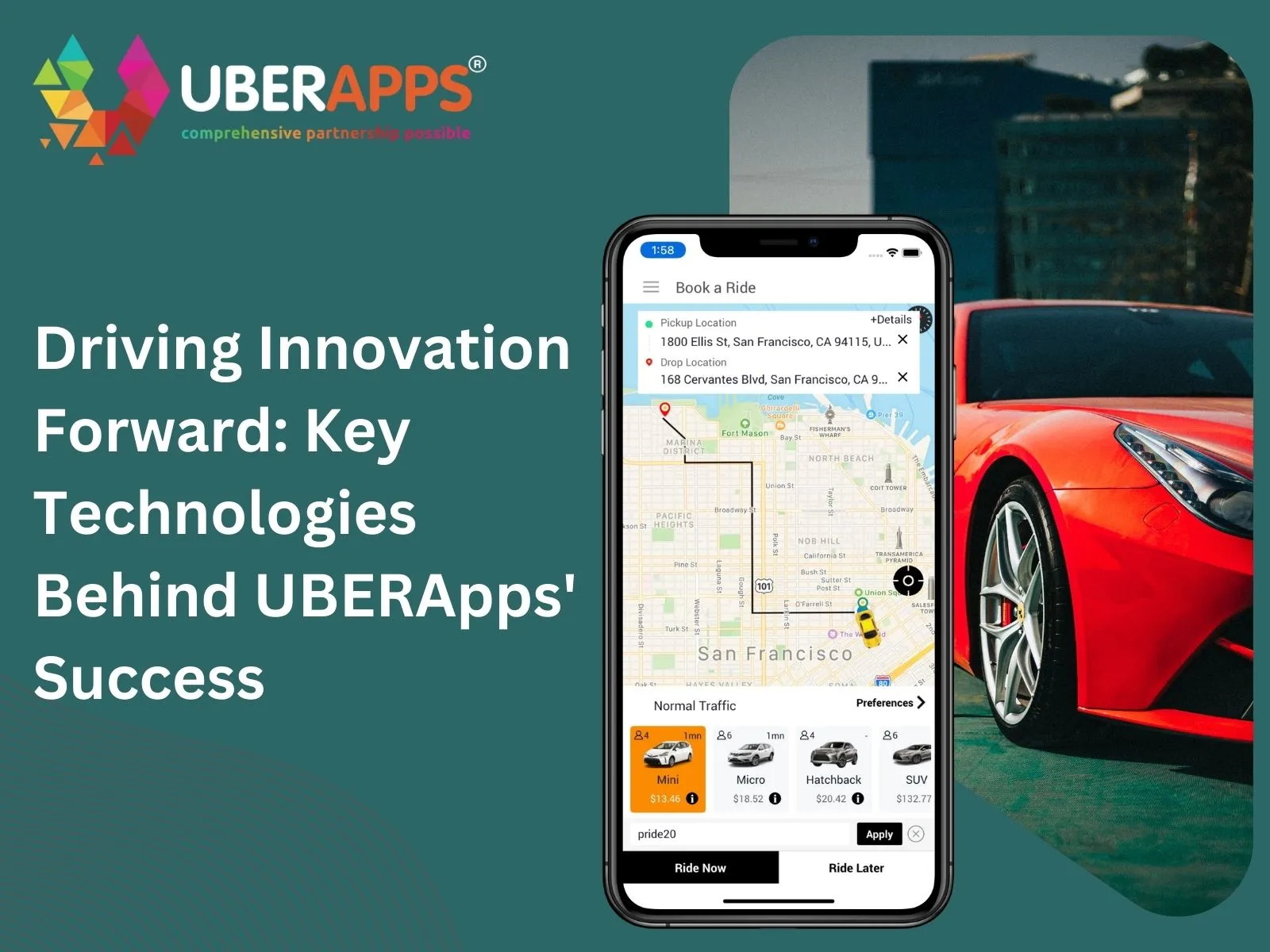
Driving Innovation Forward: Key Technologies Behind UBERApps' Success
In the fast-paced ride-sharing world, UBERApps has emerged as a dominant force, reshaping urban mobility with its innovative approach. The company's rapid growth and widespread adoption are not just results of a convenient service but are deeply rooted in its use of advanced technology. From real-time GPS tracking to artificial intelligence and big data analytics, UBERApps has leveraged cutting-edge technologies to enhance user experience, optimize operations, and maintain a competitive edge. This article dives into the key technologies behind UBERApps' success and how they continue to drive innovation forward.
UBERApps Technologies has transformed the ride-sharing industry through its innovative use of advanced technology. By integrating real-time GPS tracking, artificial intelligence, big data analytics, and cloud computing, UBERApps has enhanced user experience and operational efficiency. Its user-friendly mobile app, secure payment systems, and robust cybersecurity measures have built significant trust among users. Additionally, UBERApps' investment in emerging technologies like IoT and autonomous vehicles demonstrates its commitment to leading the future of urban mobility. As the company continues to innovate, it sets new standards for convenience, safety, and efficiency in the ride-sharing market.
The Power of Mobile App Development
At the core of UBERApps' success is a user-friendly mobile application that seamlessly connects riders and drivers. The app's intuitive interface makes it easy for users to book rides, track drivers, and make payments without hassle. Cross-platform compatibility ensures that UBERApps can reach a broad audience, supporting Android and iOS users.
Continuous app updates play a critical role in maintaining user satisfaction. By frequently refining the app's features based on user feedback and emerging trends, UBERApps ensures a smooth and efficient user experience. Features like in-app navigation, estimated arrival time (ETA), and fare estimation demonstrate the importance of robust mobile app development in sustaining user engagement and loyalty.
1 Real-Time GPS and Mapping Technology
The integration of real-time GPS and mapping technology is another cornerstone of UBERApps' success. Accurate location tracking enables users to pinpoint their pick-up and drop-off locations effortlessly. For drivers, GPS assists in efficient route optimization, minimizing delays, and enhancing customer satisfaction
In addition, GPS technology is instrumental in UBERApps' delivery services, ensuring that orders are delivered promptly. By calculating the fastest routes based on live traffic data, UBERApps minimizes wait times and maximizes efficiency, creating a reliable experience for both riders and drivers.
2 Artificial Intelligence and Machine Learning
Artificial Intelligence (AI) and Machine Learning (ML) are pivotal in UBERApps' operations. One of the most notable applications is dynamic pricing, commonly known as surge pricing. By analyzing real-time demand and supply conditions, AI adjusts prices to balance rider demand with driver availability, ensuring that riders can find rides even during peak times.
Predictive analytics, another facet of AI, helps UBERApps forecast demand patterns based on historical data, enabling proactive driver deployment. Additionally, AI algorithms enhance security by detecting fraudulent activities, such as fake ride bookings or suspicious payment transactions, thus safeguarding users and maintaining trust in the platform.
3 Big Data Analytics
UBERApps harnesses the power of big data analytics to streamline its operations and deliver personalized experiences to users. By analyzing vast amounts of data generated through rides, the platform can optimize routes, predict demand surges, and even offer personalized promotions to users.
Data-driven decision-making extends to driver management as well. Performance metrics like acceptance rates, customer feedback, and route efficiency are continuously analyzed to ensure optimal service levels. This approach not only enhances the rider's experience but also helps UBERApps manage its fleet efficiently.
4Cloud Computing Infrastructure
Cloud computing plays a crucial role in enabling UBERApps to scale seamlessly during peak demand times. By leveraging cloud-based infrastructure, UBERApps can process millions of transactions per second without significant delays. This scalability is vital for maintaining service quality during high-traffic events or rush hours.
Cloud solutions also offer cost efficiency and data storage capabilities, allowing UBERApps to manage its resources effectively. Real-time data processing and access further enhance the platform's reliability, ensuring accurate ETAs and route information.
5 Advanced Payment Processing Systems
A seamless payment experience is essential for user satisfaction. UBERApps integrates multiple payment gateways, allowing users to choose from a variety of options, including credit cards, digital wallets, and even cash in certain regions. The platform's advanced encryption and security protocols ensure that transactions are safe and secure.
These initiatives not only enhance UBER's brand image but also appeal to environmentally-conscious users.
6Internet of Things (IoT) Integration
The Internet of Things (IoT) is increasingly becoming a part of UBERApps' strategy to enhance fleet management and safety. IoT devices installed in vehicles enable real-time monitoring of speed, engine performance, and maintenance needs. This data helps predict and prevent potential breakdowns, ensuring riders remain safe.
Additionally, IoT facilitates improved navigation by integrating real-time traffic data, helping drivers avoid congested routes and reduce travel time. This integration showcases how IoT can transform traditional ride-sharing models into more efficient and reliable services.
7Cybersecurity Measures
With the massive volume of financial transactions and personal data processed daily, cybersecurity is a top priority for UBERApps. The platform employs multi-layered security protocols, including encryption, two-factor authentication, and regular security audits to protect user information.
Compliance with international data protection regulations such as GDPR ensures that UBERApps maintains high standards of data privacy. These measures not only protect users but also enhance trust in the platform, which is crucial for retaining a loyal customer base.
Conclusion
UBERApps SaaS-based taxi apps has redefined the ride-sharing industry with its relentless focus on innovation and advanced technology. From user-friendly mobile applications and real-time GPS tracking to artificial intelligence, big data analytics, and cloud computing, UBERApps has leveraged a comprehensive tech stack to deliver seamless and efficient services. The company's robust cybersecurity measures and diverse payment processing options enhance user trust and satisfaction.
By continuously investing in emerging technologies like IoT and autonomous vehicles, UBERApps is not just keeping pace with industry trends but actively shaping the future of urban mobility. The company's ability to scale efficiently, optimize operations, and provide personalized experiences is a testament to its technological prowess and strategic vision. As UBERApps continues to evolve, its commitment to innovation will remain a dominant force in the ride-sharing market, setting new standards for convenience, safety, and efficiency.
FAQS
1. How does UBERApps use artificial intelligence?
UBERApps uses AI for surge pricing, demand forecasting, and fraud detection by analyzing real-time data to optimize prices and enhance security.
2. What is the role of big data analytics in UBERApps' success?
Big data helps UBERApps optimize routes, predict demand, and personalize user experiences, improving efficiency and customer satisfaction
3. How does UBERApps protect user data and transactions?
UBERApps ensures security with encryption, two-factor authentication, and compliance with data protection regulations like GDPR.
4. Why is cloud computing crucial for UBERApps?
Cloud computing allows UBERApps to manage high data volumes efficiently, ensuring reliable service during peak times.
5. How could autonomous vehicles impact UBERApps?
Autonomous vehicles could reduce costs, improve efficiency, and lower fares, but regulatory and safety issues must be resolved first.
Author's Bio

Vinay Jain is the Founder of UBERApps and brings over 10 years of entrepreneurial experience. His focus revolves around software & business development and customer satisfaction.

